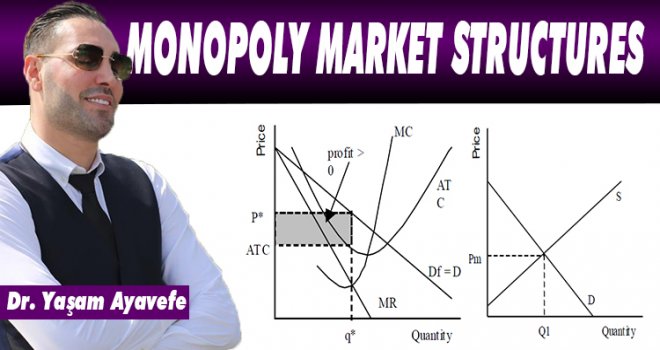



Explaining in detail the differences between competitive and monopoly market structures in terms of economic efficiency and other relevant features
Monopoly and competitive markets are two distinctive market types which entail various vital characteristics, such as market efficiency, entry, supply and demand curves, shares, comparison of prices etc. In its main characteristics a monopolistic market includes single actor which states the price level and amount of supply throughout the market and this authority has full control over the entire market.
On the other hand, competitive markets include various actors, in which no single authority has the control over market. In this study, differences between competitive and monopoly market structures in the perspectives of economic efficiency and other relevant features will be discussed in details.
The efficiency of markets can be explained by productive efficiency and allocative efficiency. In the productive efficiency, as the produced output is fixed, the production expenses or the utilized resources are kept at the minimum level. By another definition, as the production expenses or utilized resources are fixed, the produced output has to be maximized. In the case of the long run of competitive markets the price is equivalent to the minimum level of the long-run average cost curve given in Figure 1; since the procedure of entering and exiting the market has no restriction. Thus, in competitive markets, produced merchandises are sold with the lowest probable average price

Figure 1: The long-run equilibrium in a competitive market
On the other hand, in the monopoly markets, productive efficiency takes place where the price (P) is equal to the minimum level of average total cost (ATC). Thus, in the monopoly markets productive efficiency can't be accomplished as the firms create at an output that is lower compared to the min ATC output as given in Figure 2 of long-run equilibrium in monopoly markets. As a consequence, inefficiency in monopoly markets can arise due to lack of competence force with the aim of producing at the lowest probable expenses

Figure 2: The long-run equilibrium in a monopoly market
As the allocative efficiency is discussed, it can be stated that this type of efficiency arises as the available resources are dedicated to the production of goods as the society is well off when possible. Allocative efficiency can be explained as the point (through various productions points) in which is selected since it is socially preferred. In competitive market concept, price (P) is equivalent to the production marginal cost (MC).
In its simplest manner, price can be defined as the value of a good as in which the consumer receives the social benefit from it. Thus the motivation for paying the good reflects the worth of good in the perspective of the consumer. In this perspective, MC of the good is not only depicting the producer's expense but also the social cost associated with the production of that item. For instance, given the price vs. quantity graph of a book sale in Figure 3, graph entails two distinctive regions.
We gave a brief introduction to economic efficiency and other relevant features. In our second article, which will be a continuation of this article, we will examine monopoly market structures and differences in depth.
Don't forget to follow the series :)
Yaşam Ayavefe
 KKTC TÜM ADIYAMANLILAR YARDIMLAŞMA VE DAYANIŞMA DERNEĞİ AŞURE ETKİNLİĞİ GERÇEKLE..
KKTC TÜM ADIYAMANLILAR YARDIMLAŞMA VE DAYANIŞMA DERNEĞİ AŞURE ETKİNLİĞİ GERÇEKLE..
 BBC'den dikkat çeken belgesel: 'KKTC'yi neden hiçbir ülke tanımıyor?
BBC'den dikkat çeken belgesel: 'KKTC'yi neden hiçbir ülke tanımıyor?
 TC Dışişleri Bakanı Fidan: Kıbrıs Türklerinin haklı davası savunulmaya devam edi..
TC Dışişleri Bakanı Fidan: Kıbrıs Türklerinin haklı davası savunulmaya devam edi..
 Küresel yazılım sorunu kaos yarattı
Küresel yazılım sorunu kaos yarattı
 Türkiye Merkez Bankası politika faizini yüzde 50'de sabit tuttu
Türkiye Merkez Bankası politika faizini yüzde 50'de sabit tuttu
 Dereboyu'nda korkutan kaza: Araç dükkana girdi!
Dereboyu'nda korkutan kaza: Araç dükkana girdi!
 Ataoğlu: Plastik, doğaya ve insana ciddi zararlar veriyor
Ataoğlu: Plastik, doğaya ve insana ciddi zararlar veriyor